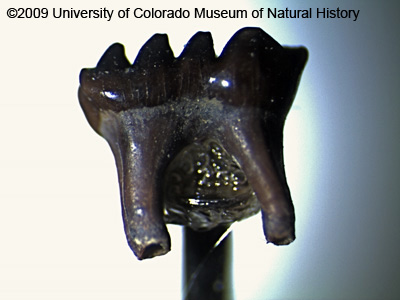

This tiny mammal tooth from the 65 million year old Lance Formation of Wyoming is a typical microfossil from this formation, just the right size for a harvester ant to carry. It came from a small multituberculate, an extinct group of mammals with unusual many-cusped teeth.

Although multituberculates have the longest fossil record of any mammal group--spanning over 100 million years--they are also the only major branch of mammals with no living descendants. Multituberculates became extinct in the early Oligocene, about 35 million years ago, perhaps out-competed by true rodents.
The Lance Formation has produced many important fossils, ranging from tiny microfossils like those collected by harvester ants to fully articulated dinosaur skeletons. It was deposited by streams on a coastal plain stretching along the shallow interior sea of the Western Interior Seaway, which cut North America in half. Dinosaurs, reptiles, fish, amphibians, birds, and small mammals lived in a wet subtropical climate very different from today's dry seasonal climate.
Learn more about multituberculates at the University of California Museum of Paleontology's Introduction to Multituberculates: The "Lost Tribe" of Mammals.
Learn more about the Lance Formation with Passport-In-Time Microvertebrate Fossil Project at the University of Wyoming Geological Museum: Late Cretaceous Paleontological Resources in the Public Eye.